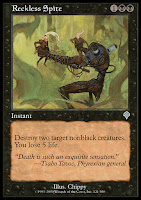Today's stream-of-consciousness post is brought to you by my most recent failed Magic: the Gathering deck construction attempt.
Collectible Card Games (CCGs) require a good amount of pre-game planning, as you must construct a 60-card deck from scratch before squaring off against an opponent. In Magic, the 'generic' victory condition is reducing your opponent to zero life before he/she does the same to you. There are several 'gimmick' cards, however, that present alternate victory conditions- one such is below, called Near-Death Experience.
A few years ago, I decided to make a deck based around this victory condition. I decided to go with white/black for my colors, as they (especially black) had a number of cards (examples below) that enabled me to lose life (which normally is a bad thing, but here was desired) while doing something cool, or profited from me having low life (Death's Shadow, for example).
So far, so good. I needed some more ways to lose life, and certain lands helped:
I was well on my way. But I needed a way to get down to 1 life without getting to 0. Here's where these two cards were key- I'll call them my 'lifelines':
With these in mind, I made my deck. The lifelines plus the victory condition were a pretty cool combo; if I could use the other cards to decrement my life total, I figured I had a good shot. I was excited to try it today . . . and got destroyed, twice, because I failed to heed the wording on my lifelines.
In any game, failure to comprehend the nuances of the rules can be catastrophic. In this case, I neglected to realize that losing life and taking damage are not inherently the same thing. From the comprehensive rules (found here):
Collectible Card Games (CCGs) require a good amount of pre-game planning, as you must construct a 60-card deck from scratch before squaring off against an opponent. In Magic, the 'generic' victory condition is reducing your opponent to zero life before he/she does the same to you. There are several 'gimmick' cards, however, that present alternate victory conditions- one such is below, called Near-Death Experience.
A few years ago, I decided to make a deck based around this victory condition. I decided to go with white/black for my colors, as they (especially black) had a number of cards (examples below) that enabled me to lose life (which normally is a bad thing, but here was desired) while doing something cool, or profited from me having low life (Death's Shadow, for example).
So far, so good. I needed some more ways to lose life, and certain lands helped:
I was well on my way. But I needed a way to get down to 1 life without getting to 0. Here's where these two cards were key- I'll call them my 'lifelines':
With these in mind, I made my deck. The lifelines plus the victory condition were a pretty cool combo; if I could use the other cards to decrement my life total, I figured I had a good shot. I was excited to try it today . . . and got destroyed, twice, because I failed to heed the wording on my lifelines.
In any game, failure to comprehend the nuances of the rules can be catastrophic. In this case, I neglected to realize that losing life and taking damage are not inherently the same thing. From the comprehensive rules (found here):
- 118.2. Damage dealt to a player normally causes that player to lose that much life. See rule 119.3.
- 118.3. If an effect causes a player to gain life or lose life, that player’s life total is adjusted accordingly.
- the details matter.
- trials/play-testing are necessary to determine the quality of a design.
I did a similarly foolish thing in 2008 at a Star Wars Miniatures tournament in Germany. I had misunderstood the targeting rules, and my friends shared my confusion. We were summarily destroyed as a result. Pay attention, folks! And test, test, test.










No comments:
Post a Comment